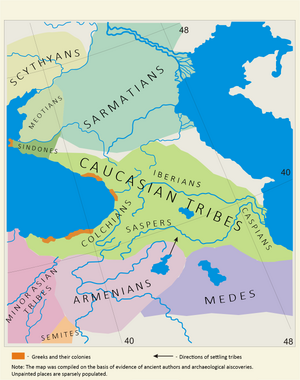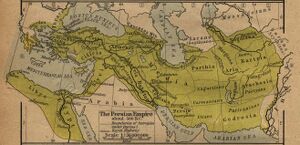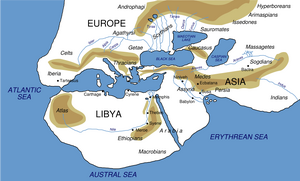Caucasus
| Author: Laxman Burdak, IFS (R). |



Caucasus is a region at the border of Europe and Asia.
Variants of name
- Parapamisadae (Anabasis by Arrian, p. 247, 269, 283, 840, 358.)
- Parapamisus (Anabasis by Arrian, p. 197, 270, 271, 273.)
- Caucasus (Anabasis by Arrian, p. 197-199, 202, 234, 247, 266-275, 284, 308, 387.)
- Caucasus (Pliny.vi.39)
- Caucasus Mountains
- Parapamisadae
- Parapamisadian
- Parapamisadians
- Kroy-khasis (Scythian)
- Shvetaparvata (श्वेतपर्वत) Mahabharata (II.25.1), (IX.36.20)
Origin of Name
Pliny the Elder's Natural History (AD 77-79) derives the name of the Caucasus from the Scythian kroy-khasis (“ice-shining, white with snow”).[1]
Location
It is situated between the Black Sea and the Caspian Sea. It is home to the Caucasus Mountains, which contain Europe's highest mountain, Mount Elbrus. Politically, the Caucasus region is separated between northern and southern parts. The southern parts consist of independent sovereign states. The northern parts are under the jurisdiction of the Russian Federation.
The northern portion of the Caucasus is known as the Ciscaucasus and the southern portion as the Transcaucasus.
The Ciscaucasus contains the larger majority of the Greater Caucasus Mountain range, also known as the Major Caucasus mountains. It includes Southwestern Russia and northern parts of Georgia and Azerbaijan.
The Transcaucasus is bordered on the north by Russia, on the west by the Black Sea and Turkey, on the east by the Caspian Sea, and on the south by Iran. It includes the Caucasus Mountains and surrounding lowlands. All of Armenia, Azerbaijan (excluding the northern parts) and Georgia (excluding the northern parts) are in South Caucasus.
The main Greater Caucasus range is generally perceived to be the dividing line between Asia and Europe. The highest peak in the Caucasus is Mount Elbrus (5,642 m) in the western Ciscaucasus in Russia, and is generally considered as the highest point in Europe.
Mention by Pliny
Pliny[2] mentions 'The Nations of India'....However, that we may come to a better understanding relative to the description of these regions, we will follow in the track of Alexander the Great. Diognetus and Bæton, whose duty it was to ascertain the distances and length of his expeditions, have written that from the Caspian Gates to Hecatompylon, the city of the Parthians, the distance is the number of miles which we have already12 stated; and that from thence to Alexandria,13 of the Arii, which city was founded by the same king, the distance is five hundred and seventy-five miles; from thence to Prophthasia,14 the city of the Drangæ, one hundred and ninety-nine; from thence to the city of the Arachosii,15 five hundred and sixty-five; from thence to Ortospanum,16 one hundred and seventy-five; and from thence to the city built by Alexander,17 fifty, miles. In some copies, however, the numbers are found differently stated; and we find this last city even placed at the very foot of Mount Caucasus!
13 See c. 25 of the present Book.
14 See c. 25 of the present Book.
15 See c. 25 of the present Book.
16 A town placed by Strabo on the confines of Bactriana, and by Ptolemy in the county of the Paropanisidæ.
17 See c. 25 of the present Book.
In Mahabharata
Caucasus may be identified with Shvetaparvata (श्वेतपर्वत) of Mahabharata (II.25.1), (IX.36.20).
Sabha Parva, Mahabharata/Book II Chapter 25 mentions that the Pandavas crossing the White mountains (शवेतपर्वत), subjugated the country of the Kimpurushas ruled by Darumaputra, after a collision involving a great slaughter of Kshatriyas, and brought the region under his complete sway.
Having reduced that country, the son of Indra (Arjuna) with a collected mind marched at the head of his troops to the country called Hataka, ruled by the Guhyakas.
Subjugating them by a policy of conciliation, the Kuru prince beheld (in that region) that excellent of lakes called Manasa and various other lakes and tanks sacred to the Rishis. And the exalted prince having arrived at the lake Manasa conquered the regions ruled by the Gandharvas that lay around the Hataka territories. Here the conqueror took, as tribute from the country, numerous excellent horses called Tittiri, Kalmasha, Manduka.
At last the son of the slayer of Paka, arriving in the country of North Harivarsha desired to conquer it. Thereupon certain frontier-guards of huge bodies and endued with great strength and energy, coming to him with gallant hearts, said to Arjuna that -
- "This country can be never conquered by you. They advised him to return. Who ever enters this region, if human, is sure to perish. Your conquests have been enough. Nor is anything to be seen here that may be conquered by you. The Northern Kurus live here. There cannot be war here. Even if you enter it, you will not be able to behold anything, for with human eyes nothing can be seen here. If, however you want anything else, tell us, so that we may do you bidding".
Thus addressed by them, Arjuna smilingly addressing them, said,--'I desire the acquisition of the imperial dignity by Yudhishthira the just, of great intelligence. If your land is shut against human beings, I shall not enter it. Let something be paid unto Yudhishthira by you as tribute. Hearing these words of Arjuna, they gave him as tribute many cloths and ornaments of celestial make, silks of celestial texture and skins of celestial origin.
Note- Above information from Mahabharata gives us very important historical information.
Pliny the Elder's Natural History (AD 77-79) derives the name of the Caucasus from the Scythian kroy-khasis (“ice-shining, white with snow”).
It means Caucasus is nothing but Shvetaparvata mentioned in shloka 1. [3]
This chapter also mentions Shakapura (शक्यं पुरं) in shloka 9 and excellent city of Sakraprastha (शक्र परस्थं पुरॊत्तमम) in shloka 20.
Thus Mahabharata is describing clearly the land of Shakas that is Scythia as mentioned by Pliny the Elder's Natural History
Culturally most diverse region
The Caucasus is one of the most linguistically and culturally diverse regions on Earth. The nation states that comprise the Caucasus today are the post-Soviet states Georgia, Armenia, and Azerbaijan.
The Russian divisions include Krasnodar Krai, Stavropol Krai, and the autonomous republics of Adygea, Karachay–Cherkessia, Kabardino-Balkaria, North Ossetia, Ingushetia, Chechnya, and Dagestan. Three territories in the region claim independence but are recognized as such by only a handful or by no independent states: Abkhazia, Nagorno-Karabakh and South Ossetia.
History
Located on the peripheries of Turkey, Iran, and Russia, the region has been an arena for political, military, religious, and cultural rivalries and expansionism for centuries. Throughout its history, the Caucasus was usually incorporated into the Iranian world. At the beginning of the 19th century, the Russian Empire conquered the territory from the Qajars.[4]
Under Ashurbanipal (669-627 BC) the boundaries of the Assyrian Empire reached as far as the Caucasus Mountains. Other ancient kingdoms of the region included Armenia, Albania, Colchis and Iberia, among others. These kingdoms were later incorporated into various Iranian empires, including Media, Achaemenid Empire, Parthia, and Sassanid Empire.
In 95-55 BC under the reign of Armenian king of kings Tigranes the Great, the Kingdom of Armenia became an empire, growing to include: Kingdom of Armenia, vassals Iberia, Albania, Parthia, Atropatene, Mesopotamia, Cappadocia, Cilicia, Syria, Nabataean kingdom, and Judea. The empire stretched from the Caucasian Mountains to Egypt and from the Mediterranean to the Caspian Sea, including a territory of 3,000,000 km2 (1,158,000 sq mi), and becoming the last strong Hellenist king, and the strongest in the region by 67 BC. By this time, Zoroastrianism had become the dominant religion of the region (except for in the Kingdom of Armenia); however, the region would go through two other religious transformations. Owing to the rivalry between Persia and Rome, and later Byzantium, the latter would invade the region several times, although it was never able to hold the region.
However, because the Kingdom of Armenia was the first nation to adopt Christianity as state religion (in 301 AD), and Caucasian Albania and Georgia had become Christian entities, Christianity began to overtake Zoroastrianism. With the Muslim conquest of Persia, the region came under the rule of the Arabs, and soon the Emirate of Armenia was formed. But after several rebellions in 884–885 AD Kingdom of Armenia became independent, and several times crushed Arab armies. At that time, the capital of the Kingdom of Armenia was Ani, with a population of 200,000 and a city of "1001 churches". It was at its peak under the reign of Gagik I, when it stretched from Byzantine Empire to Caucasian Albania, from Caucasian Iberia to Mesopotamia, including also vassal states such as Caucasian Albania and Caucasian Iberia, until in 1045 AD the kingdom was conquered by Byzantine Empire. In the 12th century, the Georgian king David the Builder drove the Muslims out from Caucasus and made the Kingdom of Georgia a strong regional power.
In 1194–1204 Georgian Queen Tamar's armies crushed new Turkish invasions from the south-east and south and launched several successful campaigns into Turkish-controlled Southern Armenia. The Georgian Kingdom continued military campaigns outside of Caucasus. As a result of her military campaigns and the temporary fall of the Byzantine Empire in 1204, Georgia became the strongest Christian state in the whole Near East area. The region would later be conquered by the Ottomans, Mongols, local kingdoms and khanates, as well as, once again, Persia, until its subsequent conquest by Russia.
In modern times, the Caucasus became a region of war among the Ottoman Empire, Iran and Russia, and was eventually conquered by the latter (see Caucasian Wars).
Migrations from Indian to north western countries
Hukum Singh Panwar (Pauria)[5] writes that We may now cite at some length from Pococke[6] who has traced Indian migrations to all corners of the world solely through linguistic similarities. This extreme reliance on phonetic similarities seems to weaken his argument, but there is ample support, from other disciplines, techniques and lines of investigation, for his claims. Further, the large body of data, he has massed together cannot be brushed away lightly. When supported by other evidence, his thesis becomes incontrovertible. According to Pococke a great number of adventurous preux chevalier tribes from India migrated to Spain, Italy, Greece, Asia Minor,Persia, Colchis, Armenia and the Caucasus region, all of which provide distinct and startling evidence of Indian colonization in great profusio. We have tried (Appendix No.6) to pinpoint the Indian names and places of the origin of the migrated tribes as well as the altered forms of their names in their new settlements in other countries. The appendix indicating all this, is by no means, exhaustive. It may not be unnecessary here to point out that in some countries the presence of Indian tribes can be construed by their names, though distorted, while, in others their identity can be traced by place names in these transformed phonemic nomenclatures. All the more significant is the fact that almost all the tribes are considered Saca-Getae (Jats) or Scythians by the learned scholar[7].(cf. Appendix No.6).
Pococke[8] believes that the major migrations took place from India as a result of internecine wars and religious persecutions in which the Buddhists had been the main victims.
To these may be added the Parasurama-Haihayas (Scythians) wars, Sagar's war against Haihayas and their allies (Sakas, Parthas,Pahlavas etc) the Dasarajna Wars, the Rama-Ravana Yudha, the Mahabharata war. Pococke lays special stress on the virulent religious strife for a long time between the Brahmins and the Buddhists for supremacy, leading to Brahmanic victory and the gigantic expulsion of the Buddhists. Pococke claims[9] that this was the most crucial event which compelled migrations and
The Jats:Their Origin, Antiquity and Migrations:End of page 307
banishment of the vanquished to the north-western countries. The Saga of the Kurus and Pandus, though ostensibly political was in reality, as Pococke[10] contends, a struggle between the Brahminical and the Buddhistic parties. Profound night clouds this portion on Indian history. What Pococke regards as clear is that the emigrants coasted along the shores of Mekran, traversed the mouth of Persian Gulf. Adhering to the sea-board of Oman, Hadramant and Yemen (the Eastern Arabia), they sailed up the Red Sea, and ascending the mighty stream - the Nile - that fertilizes a land of wonders, founded the kingdoms of Egypt, Nubia, Abyssinia[11] and Ethiopia. Fhilostratus, Julius Africanus, Eusebius and Syncellus, the Greek writers[12] assert that the Ethiopians were originally an Indian race, emigrated from the river Indus and settled in the vicinity of Egypt. This assertion cannot be dismissed lightly.
External links
References
- ↑ "Natural History," book six, chap. XVII
- ↑ Natural History by Pliny Book VI/Chapter 21
- ↑ स शवेतपर्वतं वीरः समतिक्रम्य भारत, थेशं किं पुरुषावासं दरुमपुत्रेण रक्षितम (II.25.1)
- ↑ "Caucasus and Iran". Encyclopædia Iranica
- ↑ The Jats:Their Origin, Antiquity and Migrations/The identification of the Jats, pp.307-308
- ↑ Pococke, E; India in Greece, Indian Reprint, 1972, p. 32, 47, 134.
- ↑ Ibid., pp.38, 51ff, 63, 70, 124, 148, 159, 178, 195, 205, 229, 242, 251, 255,300.
- ↑ For further study please cf. C. Wordsworth, D.O., 'Greece, Pictorial and Descriptive; Grote, His. of Greece; Niebuh" His. of Rome; Troyer, Ramayana; Tod, Ann; Is and Antiquities of Rajasthan; Ency. Metropolitania; Smith, Muth. Lex., vol.I Homer, Odessey, Iliad; Asiatic Researches; Mure, His. of Greek Literatura, . Vol.I; Strabo's Geographia; Wilson, skt. Les.; Kruse, Hellas; Smith, Dic. of Astiq.; Hamilton E, Ind. Gaz., Vol.I; Thoronton, Geog. of Ph.; Thirliwall, His. of Greece; Thueydide, Genesis and App. No. XX in Pococke's Ind. in Greece
- ↑ Ibid., Chs VI-XV
- ↑ Ibid., p. 300. Dr. Buddha Prakash describes the Epic war as the 'Saga of the Sakas'.
- ↑ Ibid., p.43
- ↑ Ibid., p. 205.

